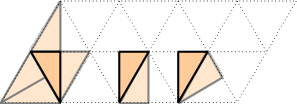Polydrafters are formed from 30°, 60°, 90° triangles. The name, coined by Ed Pegg Jr., refers to the drafting tool of the same shape. The joints between the pieces are restricted as follows: a mirror copy along either of the shorter sides; a mirror copy or 180° rotation along the hypotenuse; a copy with the right angle placed at the centre of the hypotenuse. These joints are shown below. Polydudes consist of those polydrafters with all joints longer than the shortest side, and are marked with an asterisk. Extended or improper polydrafters are made using all possible joints.
Monodrafter - 1 (1 tile) Monodudes - 0
|
|
Didrafters - 6 (12 tiles) Didudes - 3
 |
|
|
|
 |
 |
| 1* | 2* | 3* | 4 | 5 | 6 |
Extended Didrafters - 7 (14 tiles)
 |
|
|
|
|
 |
 |
| 1 | 2 | 3 | 4 | 5 | 6 | 7 |
Tridrafter - 14 (42 tiles) Tridudes - 1, Extended tridrafters - 74
 |
 |
 |
|
 |
 |
| 1* | 2 | 3 | 4 | 5 | 6 |
|
|
 |
 |
 |
 |
 |
| 7 | 8 | 9 | 10 | 11 | 12 |
 |
 |
||||
| 13 | 14 |
| Polydrafters | Polydudes | Extended polydrafters |
| Tetradrafters - 64 | Tetradudes - 9 | Extended Tetradrafters - 977 |
| Pentadrafters - 237 | Pentadudes - 15 | |
| Hexadrafters - 1024 | Hexadudes - 59 | |
| Heptadrafters - 4254 | Heptadudes - 152 | |
| Octadrafters - 18664 | Octadudes - 513 | |
| Ennedrafters - 81865 | Ennedudes - 1539 |
